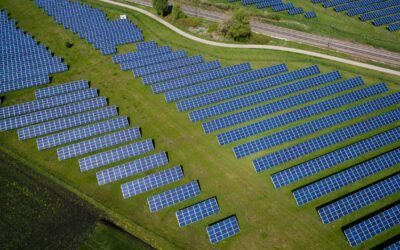The National Energy Administration has formulated targets for annual renewable energy consumption for the period 2021-2030, with a target of 40% of total electricity consumption in each province to come from renewable sources by the end of the period • The new five-year plan (2021-2025) mandates a reduction of energy consumption of 13.5% per unit of GDP, and an 18% reduction of CO2 emissions per unit of GDP. This is a challenge as the urbanization continues and the middle class expands, meaning a growth of consumption-based emissions • The Beijing 2022 Winter Olympic Games will be completely powered by renewable energy. Measures taken to achieve this include the development of new facilities to supply the event with green and reliable electricity. Read more about sustainable heating and cooling developments in China below

In February 2021, the National Energy Administration (NEA) issued the proposed strategy and targets for the renewable power consumption from 2021 to 2030, and has been soliciting opinions from interest groups.
The government will continue to set mandatory targets as well as incentivized targets for increased use of renewable power and non-hydro renewable power. The idea is to raise the renewable consumption targets for each province year by year, and gradually reduce the difference in the proportion of consumption among provinces in the next ten years, to realize the goal that all provinces will bear the responsibility for the development and consumption of renewable power fairly by 2030.
For the renewable power consumption target, the government requires that by 2030, renewable energy will have a share of 40% of the total electricity consumption in each province. The difference between the actual value in 2021 and the 2030 target will be evenly distributed within the next nine years. Regarding the non-hydro renewable power consumption targets, the government requires that the national share in 2030 should reach 25.9% of the total electricity consumption, that is, the average annual growth rate of 2022-2030 needs to reach 1.47%.
Chinese policymakers have set no upper limit on how much new wind and solar power capacity can be added to the grid in 2021, while also reserving a set amount of subsidies for residential solar installations, underscoring the government’s support for increasing renewable energy use.
Data indicates that China had connected 10.42 gigawatts (GW) of offshore wind energy capacity to the power grid as of the end of April 2021 representing an increase of 15.8% compared with the end of last year.
The year 2021 is the 1st year of China’s 14th Five-Year Plan, and by the end of 2025, the government wants to scale up the share of solar and wind power in total power consumption to 16.5%. The government encourages investors and developers to speed up solar and wind power plant construction in the country.
Carbon neutrality has been the buzzword in China in recent months.
Short-term goals: The new five-year plan requires a 13.5% reduction in energy consumption per unit of GDP during the 2021–25 period and an 18% cut in carbon dioxide emissions per unit of GDP.
China launched first real-time carbon emissions monitoring system for power companies in Jiangsu province in May 2021. Power companies’ carbon emission were previously calculated mainly based on coal consumption; the new system can conduct real-time monitoring of carbon emission.
Key approach: A gradual replacement of fossil energy with non-fossil energy is the key to reach the ambitious carbon reduction goals. Major increase in carbon emission during 2015 to 2020 came from petroleum and natural gas consumption. To transition away from a fossil energy-dominant structure to a non-fossil one, China needs to control total energy consumption and develop non-fossil energy to meet the incremental demands for 2021 to 2025.
Key challenge: As urbanization continues and the middle class expands in China, the growth of consumption-related emissions will remain strong, especially energy use by automobiles and houses. The climate commitments must be realized in a way that will not affect people’s quality of life.
The deadline is tight. According to research sponsored by the Energy Foundation, the building and industrial sectors need to achieve peak emissions by 2025 and the transportation sector by 2030–35. For the power sector, carbon emissions should peak and decline rapidly as soon as possible before 2025 to support other sectors while safeguarding energy use.
Key policy-makers: Ministry of Ecology and Environment (MEE) is the main agency responsible for issuing policies related to climate change and the carbon goals, including setting up and managing the highly anticipated national carbon emission trading market. National Development and Reform Commission (NDRC) is in charge of drafting policies on a macro level, it also focuses on resource conservation and energy-saving issues. The central bank leads green finance-related work.
Green power supply, green venue construction and low-carbon transportation are among the measures that Beijing 2022 is taking in order to honor its promise of hosting a green game.
To realize the vision of making the Beijing 2022 Winter Olympic Games the first Olympic Games in history at which all venues are powered by green and renewable energy, the State Grid Beijing Electric Power Company has developed new facilities to supply the event with reliable and green electricity.
Zhangbei, rich in wind and solar power resources, is a large, state-planned, renewable energy base. Zhangbei flexible DC grid pilot project will support the connection of Zhangjiakou’s green power with Beijing’s power grid, transmitting approximately 14 billion kilowatt-hours of green power to Beijing annually.
The green power from Zhangbei will directly be supplied to the venues in Beijing and Yanqing competition areas during the Olympics. The venues in Zhangjiakou will also use the locally generated green power. This means Beijing Winter Olympics will be the first Olympic Games to power all the venues with green power.
After going into operation, the project is expected to save 4.9 million tons of standard coal and reduce carbon dioxide emissions by 12.8 million tons annually.
Beijing’s commitment in reducing carbon footprint is also seen in the 2022 Games’ full use of venues from the 2008 Summer Games, which effectively saved space and reduced the waste caused by demolition.
To stay updated on news for sustainable heating and cooling, follow us on Twitter and LinkedIn, and subscribe to our Newsletter.
Sweden is at the forefront of decentralised heat networks technology. Our aim for “Sustainable Heating & Cooling by Sweden” is to facilitate knowledge sharing between British, French and Swedish stakeholders and develop and encourage environmental and economic best practice.
To find out how we can help you and your organisation, please contact our London or Paris-based “SHC” teams. We can introduce you to leading consultants, suppliers of technology and services who will be pleased to share know-how of the development of sustainable heating & cooling solutions.


